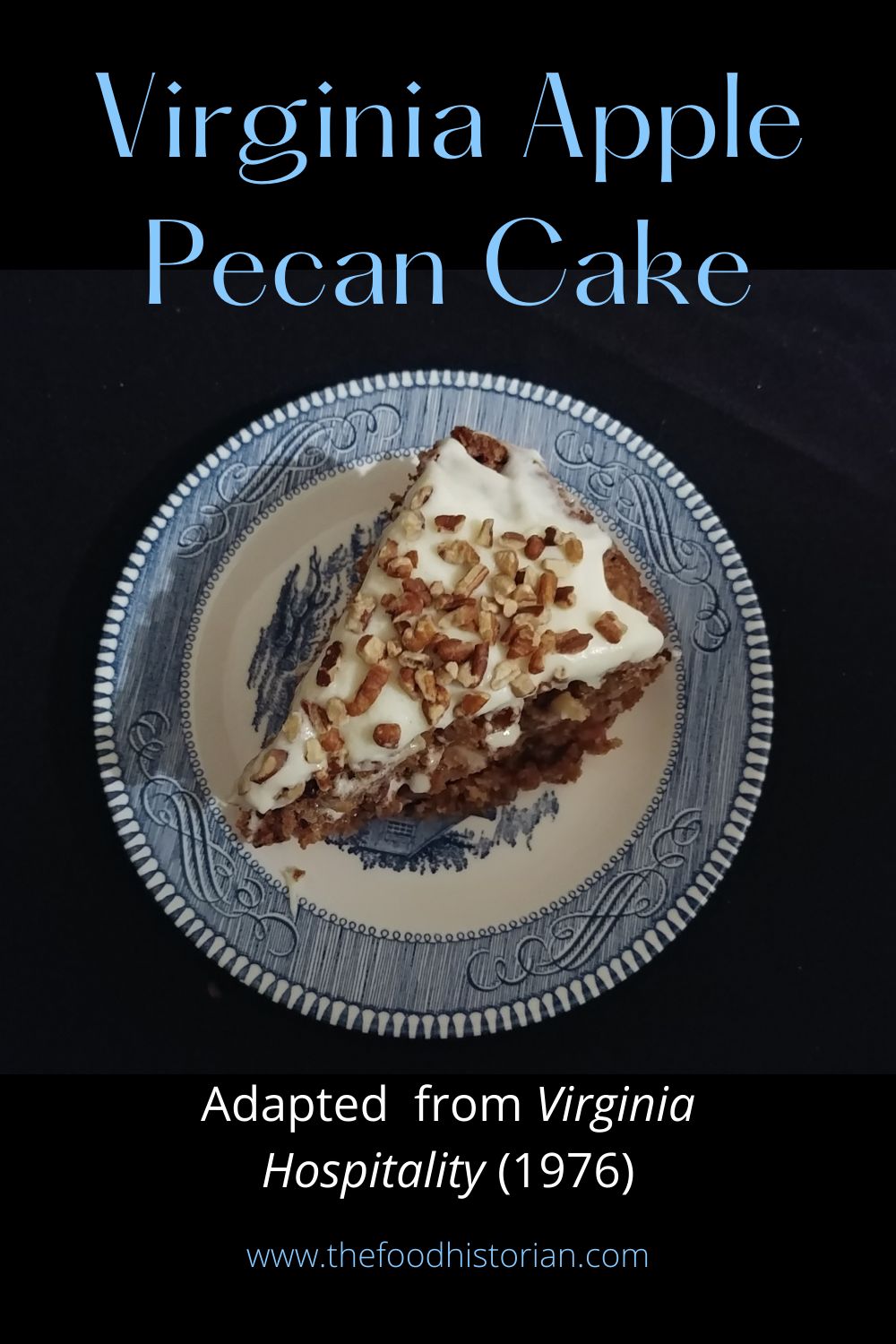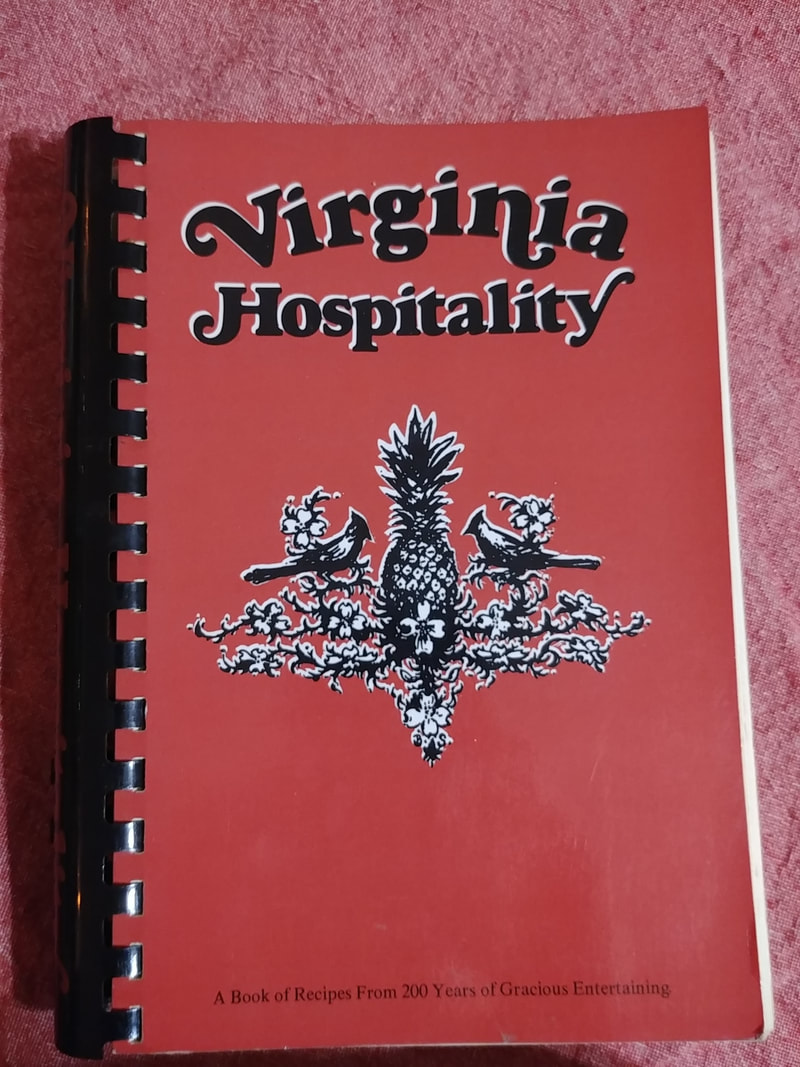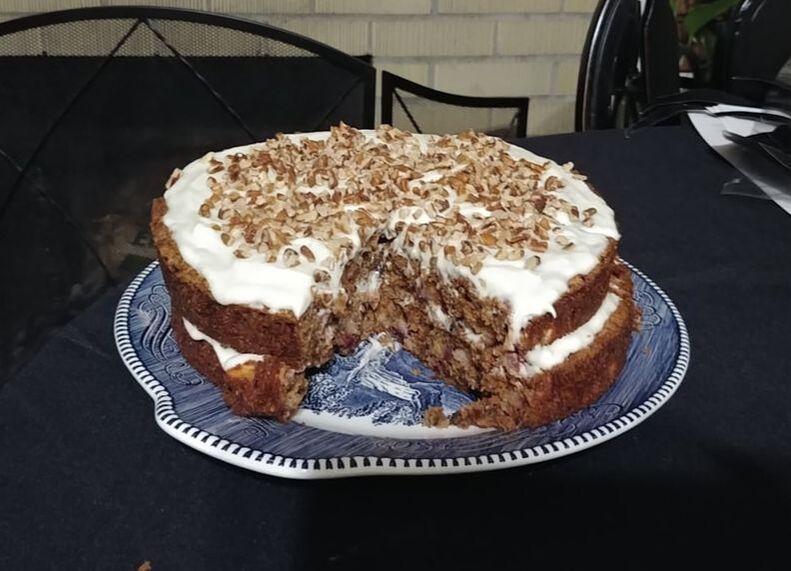|
Here we are, five days later, and we finally have an election result. I made this cake on election day because I didn't have yeast for "real" election cake (more on that below), I had a bunch of homegrown Liberty apples to use up, and felt like making a layer cake with my new cake pans (somehow I lost one of my old pair of cake pans?). I had made this Virginian Apple Cake before, but it didn't turn out too great. So I tried again and did some tweaking and this time it turned out WONDERFULLY. It's now officially Virginia Apple Pecan Cake, in my book. Virginia Apple Pecan CakeThis recipe is from the community cookbook, Virginia Hospitality, first published in 1976 for the Bicentennial, but my copy is the ninth printing, from 1984. It's a fascinating little recipe - the only liquid comes from the eggs and softened butter and the apples themselves. The batter is VERY thick, but bakes up beautifully - a light and somewhat fragile texture - essentially just apples and nuts held loosely together by a light spiced batter. Here's the original recipe: The original recipe reads: 2 cups flour 2 cups sugar 2 teaspoons baking soda 1 teaspoon cinnamon 1/2 teaspoon nutmeg 1/2 teaspoon salt 4 cups apples, peeled & finely diced 1/2 cup walnuts, chopped 1/2 cup butter, softened 2 eggs, slightly beaten Preheat oven to 325. Grease a 9 x 13 baking pan. Sift dry ingredients into a bowl. Add remaining ingredients and beat until JUST combined. Batter will be thick. Spread evenly in pan. Cook for 1 hour or until done. "Delicious when served warm topped with ice cream or whipped cream." It certainly is perfectly lovely as a plain sheet cake, but I wanted something a little different, so I made some changes not only to the style but the recipe itself. Here's my recipe: 2 cups flour (I used 1 cup all-purpose, 1 cup whole grain rye) 1 1/2 cups sugar 2 teaspoons baking soda 1 teaspoon cinnamon 1/2 teaspoon freshly grated nutmeg (or thereabouts) 1/2 teaspoon salt at least 4 cups apples, finely diced 1 cup chopped pecans 1/2 cup butter, softened 2 eggs, slightly beaten Preheat oven to 325 F and grease two 9 inch round cake pans. Add all dry ingredients to a large bowl and whisk to combine. Add chopped pecans and whisk to combine. Take 4-6 freshly washed Liberty apples (they will be small) - slice into thin slices and then cut crosswise to make fine dice. You can leave the skin on. Fill at least 4 cups of apples and add to dry ingredients, then cut up the rest of the apple you were slicing and add to the bowl. In a small separate bowl, melt the stick of butter slightly in the microwave (10-20 seconds) and add to the big bowl. Add 2 eggs and with a wooden spoon combine all, stirring and folding until no loose flour is left. Divide into two pans and bake 45-60 minutes or until the cake springs back in the center to the touch. Cool on a rack. Salted Caramel (or Maple) Buttercream FrostingI happened to have some Monin Salted Caramel Syrup laying around the house, but if I make this again I'll probably use maple syrup and some salt. The salty-sweet frosting makes a nice (but rich) contrast to the not-as-sweet cake. 1 stick salted butter, softened 2 tablespoons to 1/4 cup syrup powdered sugar salt With a fork, beat the syrup into the softened butter. Add enough powdered sugar to make a thick frosting. Taste and add salt a few grains at a time, tasting between each addition. When the cakes are cool, frost one layer, then top with the other, and frost the top. This won't be enough to frost the whole cake, just the layers. Sprinkle more chopped pecans on top for decoration. A Brief History of Election CakeElection Cake is a democratic tradition that dates back to the earliest days of our Republic, even before we were officially our own country. Puritans in New England celebrated it in the 17th century, but was important throughout the 18th and 19th centuries. Election Day was once held in the spring, but in 1845 Election Day was codified to be held on the first Tuesday after the first Monday in November. Back when only propertied free white men were allowed to vote, election cake was nonetheless part of community celebrations around election day. and the similar Muster Day, a celebration from the Muster Act of 1792, which called every able-bodied man aged 18 to 45 to muster for the local militia. Generally held in September and largely in effect until after the Civil War, Muster Day often required the bribe of alcohol, and communities would often have county-fair type celebrations as well. Like Muster Day, Election Day was a community affair, and that necessitated some publicly accessible food. Election Cake is in the tradition of Medieval English great cakes - expensive and enormous confections of fine flour, sugar, expensive imported dried fruits, spices, and nuts and soaked with wine or alcohol. The New England tradition was nearly identical, only the ingredients were much less expensive by that point. Like many old-fashioned cakes, Election cake is not leavened with baking soda or baking powder - it's leavened with yeast, generally homemade yeast like potato yeast. And because it is meant to serve a crowd, the proportions are enormous. The flour and sugar are measured in pounds, as many as a dozen. The generally accepted first published recipe of Hartford Election Cake comes from Amelia Simmons' American Cookery, first published in 1796 in Hartford, CT (another run was printed in Albany, NY also in 1796). Which makes me wonder if Hartford Election Cake wasn't an homage to the state in which it was published. Election Cake began to wane in popularity as the 19th century wore on, in part thanks to developments in cake baking technology, including the development of chemical leaveners like baking soda and baking powder. But in 1889, Ellen Wadsworth Johnson published a cookbook entitled, Hartford Election Cake and Other Recipes. Notable for its inclusion of ELEVEN separate recipes for Election Cake, the cookbook is nonetheless full of more conventional recipes. The title may have something to do with the fact that it was published in Hartford, Connecticut, despite the fact that it was written as a benefit for a church in New Hampshire. In her introduction, Ellen Wadsworth Johnson notes that most of the recipes come from "manuscript sources," indicating that even in 1889 it may have been a historical document. Maybe next year I'll have the time and energy to tackle a real election cake recipe, but for the meantime, Virginia Apple Pecan Cake will have to make a good substitute, and one you can eat any time of year. Did you make an election cake this year? Election Cake Resources
The Food Historian blog is supported by patrons on Patreon! Join us for awesome members-only content like free digitized cookbooks from my personal collection, e-newsletter, and even snail mail from time to time!
0 Comments
|
AuthorSarah Wassberg Johnson has an MA in Public History from the University at Albany and studies early 20th century food history. Archives
July 2024
Categories
All
|









 RSS Feed
RSS Feed